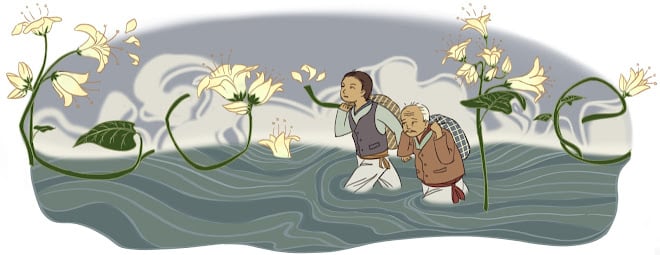Exploring the Artistry of Lee Jung-seob

Image Courtesy: Google Doodle
Lee Jung-seob (10 April 1916 – 6 September 1956) was a Korean artist, most known for his oil paintings such as “White Ox”.
Life and Career
He was born on 10 April 1916, in the city of Pyeongyang, which is now part of North Korea. He is known for his distinctive style, which combines traditional Korean ink painting techniques with modern Western painting styles.
Lee Jung-seob was born into a privileged family in Pyongwon County, South Pyongan Province, located in present-day North Korea. His family owned vast expanses of land, and his older brother, who was twelve years his senior, managed the largest department store in Wonsan during that era. Following their father’s demise in 1918, Lee’s brother assumed a paternal role in the family. Lee’s educational journey began at Jongno Primary School in Pyongyang. It was during this time that he stumbled upon replicas of Goguryeo tomb murals at the Pyongyang Prefectural Museum near his school. The immense scale and vibrant wall paintings captivated the young Lee, igniting his passion for art.
In 1930, Lee embarked on his formal art education at Osan High School in Jeongju. The school, independently funded by Korean Christian nationalists, aimed to cultivate future leaders in defiance of Japanese colonial rule. Amidst the backdrop of frequent anti-colonial socialist protests led by student activists, Lee found inspiration in his high school art teacher, Im Yong Ryeon, who recognized and nurtured his diverse artistic talents. Blessed with family wealth, Lee had the opportunity to pursue his artistic aspirations, laying the foundation for his journey to become a renowned artist.
Lee’s early works were heavily influenced by traditional Korean art, and he studied under several prominent Korean artists. He later went on to study Western art at the Tokyo School of Fine Arts in Japan, where he was exposed to new techniques and styles. Throughout his career, Lee created a wide range of works, including paintings, prints, and sculptures. His works often depicted everyday life in Korea, including scenes of rural landscapes, village life, and traditional Korean dress.
Lee’s most famous work is his series of “Bull” paintings, which he began in the 1950s. These works depict bulls in various poses and styles, and they are known for their bold colours and strong brushstrokes. In 1955, he held only one private exhibition at the Midopa Gallery.
He suffered from a type of schizophrenia credited to longings for his family and stress from life hardships. In his loneliness, Lee turned to alcohol and died of hepatitis on 6 September 1956 in Seoul.
Notable Works
Lee Jung-seob, a significant figure in Korean modern art, produced a body of work that reflects his unique style and vision. Some of his notable works include:
- Bull (1936): “Bull” is one of Lee Jung-seob’s most famous works, showcasing his mastery of expressionist techniques. The painting depicts a bull in a dynamic and energetic manner, capturing the raw power and intensity of the animal.
- Bullfight (1937): In “Bullfight,” Lee portrays the traditional Korean sport of bullfighting with vivid colors and bold brushstrokes. The painting captures the excitement and drama of the event, highlighting Lee’s ability to convey emotion through his artwork.
- Pieta (1949): “Pieta” is a poignant depiction of the Virgin Mary cradling the body of Jesus after the Crucifixion. Lee’s interpretation of this iconic scene reflects his deep spiritual and emotional sensibilities, as well as his skill in capturing human suffering and compassion.
- Crucifixion (1954): In “Crucifixion,” Lee explores themes of sacrifice, redemption, and faith through his powerful portrayal of the crucified Christ. The painting reflects Lee’s engagement with Christian imagery and his ability to infuse traditional subjects with modern expressionist elements.
- Mother and Child series: Lee Jung-seob created several works depicting mothers and children, often emphasizing the bond between parent and child and the universal themes of love, nurturing, and protection. These paintings showcase Lee’s sensitivity to human relationships and his ability to evoke deep emotions through his art.
- Self-Portrait (1951): Lee’s self-portrait provides insight into the artist’s inner world and psyche. With bold brushstrokes and intense colors, Lee captures his own likeness with a sense of introspection and self-awareness, offering viewers a glimpse into his personal struggles and aspirations.
These notable works by Lee Jung-seob demonstrate his profound artistic talent, his engagement with universal themes, and his contribution to the development of modern Korean art.
Award and Legacy
Lee’s art had a significant impact on the development of modern Korean art, and his works continue to be celebrated and studied today. On 10 April 2012, Google celebrated Lee Jung-seob’s 96th Birthday with a doodle.
FAQ on Lee Jung-seob
- Who was Lee Jung-seob?Lee Jung-seob (1916–1956) was a renowned Korean modern artist known for his expressive and emotionally charged paintings. He is considered one of the most influential figures in 20th-century Korean art.
- What is Lee Jung-seob best known for?Lee Jung-seob is best known for his dynamic and expressive paintings that often depict themes of struggle, suffering, and human emotion. His works frequently feature bold brushstrokes, vivid colors, and powerful imagery.
- What style of art did Lee Jung-seob practice?Lee Jung-seob was associated with the expressionist movement and is known for his emotionally charged and gestural style of painting. His works often convey a sense of raw energy and intensity, capturing the inner turmoil and emotions of his subjects.
- What are some of Lee Jung-seob’s most famous works?Some of Lee Jung-seob’s most famous works include “Bull,” “Bullfight,” “Pieta,” “Crucifixion,” and his series of paintings depicting mothers and children. These works showcase his mastery of expressionist techniques and his ability to evoke deep emotional responses from viewers.
- What themes did Lee Jung-seob explore in his art?Lee Jung-seob’s art often explored themes of struggle, suffering, human relationships, and spirituality. He was particularly interested in depicting the human condition and the universal experiences of joy, pain, and redemption.
- What was Lee Jung-seob’s artistic background?Lee Jung-seob studied art at the Tokyo School of Fine Arts in Japan and was influenced by Western modern art movements such as expressionism and surrealism. He later returned to Korea and became a prominent figure in the Korean art scene.
- What is the significance of Lee Jung-seob’s art in Korean culture?Lee Jung-seob’s art played a significant role in shaping the development of modern Korean art. His emotionally charged paintings resonated with audiences and contributed to a greater appreciation of expressionist and modernist aesthetics in Korean culture.
- How did Lee Jung-seob’s life and experiences influence his art?Lee Jung-seob’s tumultuous life, marked by personal struggles and political upheaval, deeply influenced his art. His paintings often reflected his own experiences of hardship and adversity, as well as his profound empathy for the human condition.
- What is Lee Jung-seob’s legacy?Lee Jung-seob’s legacy continues to endure in Korean art and culture. He is celebrated for his groundbreaking contributions to modern art and his ability to capture the complexities of the human experience through his powerful and evocative paintings.
Observer Voice is the one stop site for National, International news, Sports, Editor’s Choice, Art/culture contents, Quotes and much more. We also cover historical contents. Historical contents includes World History, Indian History, and what happened today. The website also covers Entertainment across the India and World.

